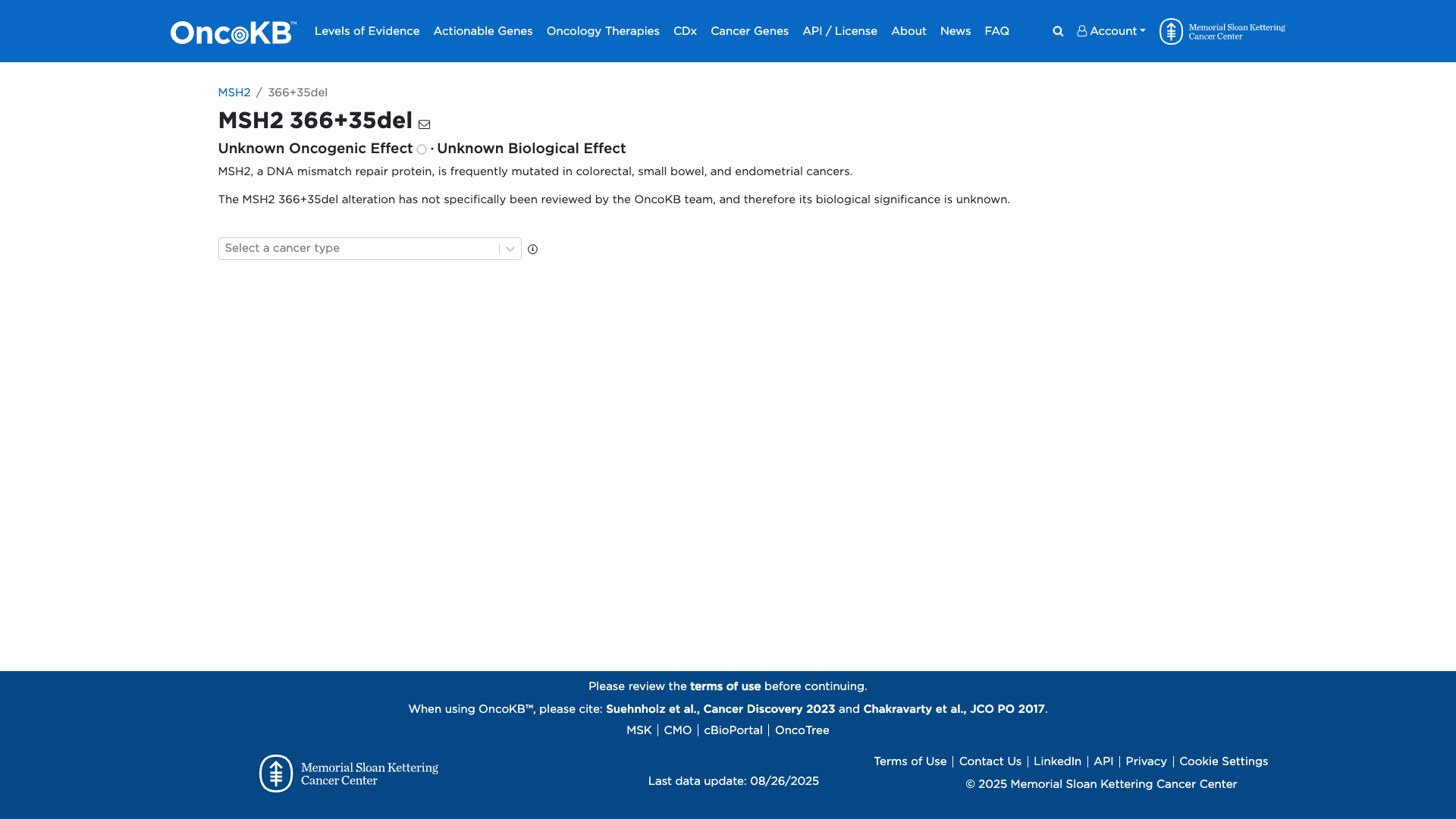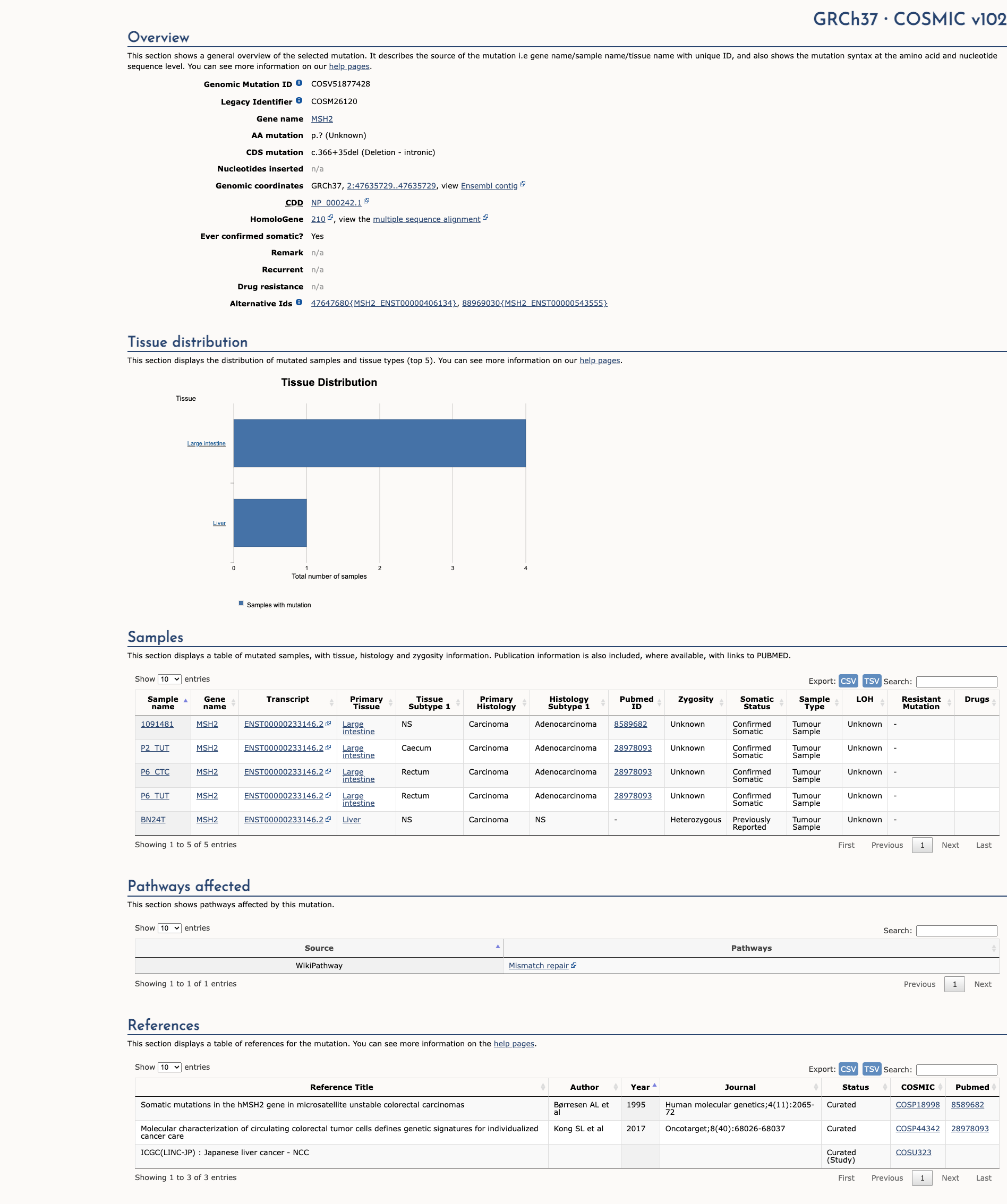MSH2 c.366+35del, p.?
NM_000251.2:c.366+35del
COSMIC ID: COSM26120, COSN27008413
Variant of Uncertain Significance (VUS)
The intronic MSH2 c.366+35delT variant is absent from population databases, predicted to have no splicing impact by SpliceAI, and is located beyond canonical splice sites. Only PM2_supporting, BP4_supporting, and BP7_supporting are met; no pathogenic or additional benign criteria apply. Therefore, classification remains Variant of Uncertain Significance (VUS).
ACMG/AMP Criteria Applied
PM2
BP4
BP7
Genetic Information
Gene & Transcript Details
Gene
MSH2
Transcript
NM_000251.3
MANE Select
Total Exons
16
Strand
Forward (+)
Reference Sequence
NC_000002.11
Alternative Transcripts
| ID | Status | Details |
|---|---|---|
| NM_000251.2 | RefSeq Select | 16 exons | Forward |
| NM_000251.1 | Alternative | 16 exons | Forward |
Variant Details
HGVS Notation
NM_000251.2:c.366+35del
Protein Change
?
Location
Exon 2
(Exon 2 of 16)
5'Exon Structure (16 total)3'
Functional Consequence
Loss of Function
Related Variants
Alternate Identifiers
COSM26120, COSN27008413
Variant interpretation based on transcript NM_000251.3
Genome Browser
Loading genome browser...
HGVS InputNM_000251:c.366+35del
Active Tracks
ConservationRefSeqClinVargnomAD
Navigation tips: Use mouse to drag and zoom. Click on features for details.
Clinical Data
Population Frequency
Global Frequency
0.0 in 100,000
Extremely Rare
Global: 0.0%
0%
0.05%
0.1%
1%
5%
10%+
ACMG Criteria Applied
PM2
This variant is not present in gnomAD (PM2 criteria applies).
Classification
Unknown
Publications (0)
No publication details.
Clinical Statement
Functional Impact
Functional Domain
Hotspot Status
Not a hotspot
Domain Summary
This variant is not located in a mutational hotspot or critical domain (0 mutations).
Related Variants in This Domain
Functional Summary
The MSH2 366+35del variant has not been functionally characterized, and its biological significance remains unknown.
Database Previews
OncoKB

JAX-CKB

Click on previews to view full database entries. External databases may require institutional access.
Computational Analysis
Pathogenicity Predictions
Predictor Consensus
Unknown
PP3 Applied
No
VCEP Guidelines
Applied ACMG/AMP Criteria (VCEP Specific) VCEP Guidelines
PVS1
PVS1 (Not Applied) Strength Modified
According to VCEP guidelines, the rule for PVS1 is: "Variants at IVS±1 or IVS±2 where exon skipping or use of a cryptic splice site disrupts reading frame and is predicted to undergo NMD". The evidence for this variant shows: c.366+35delT is outside the canonical splice sites (at +35). Therefore, this criterion is not applied.
PS1
PS1 (Not Applied) Strength Modified
According to standard ACMG guidelines, the rule for PS1 is: "Same amino acid change as a previously established pathogenic variant regardless of nucleotide change". The evidence shows: this intronic variant does not change an amino acid. Therefore, this criterion is not applied.
PS2
PS2 (Not Applied) Strength Modified
According to standard ACMG guidelines, the rule for PS2 is: "De novo (both maternity and paternity confirmed) in a patient with the disease and no family history". The evidence shows: no de novo data are available. Therefore, this criterion is not applied.
PS3
PS3 (Not Applied) Strength Modified
According to standard ACMG guidelines, the rule for PS3 is: "Well-established in vitro or in vivo functional studies supportive of a damaging effect on the gene or gene product". The evidence shows: no functional studies have been performed. Therefore, this criterion is not applied.
PS4
PS4 (Not Applied) Strength Modified
According to standard ACMG guidelines, the rule for PS4 is: "The prevalence of the variant in affected individuals is significantly increased compared with controls". The evidence shows: no case-control or statistical data. Therefore, this criterion is not applied.
PM1
PM1 (Not Applied) Strength Modified
According to standard ACMG guidelines, the rule for PM1 is: "Located in a mutational hot spot and/or critical and well-established functional domain without benign variation". The evidence shows: variant is intronic and not in a known functional domain. Therefore, this criterion is not applied.
PM2
PM2 (Supporting) Strength Modified
According to VCEP guidelines, the rule for PM2 is: "Absent/extremely rare (<1 in 50,000 alleles) in gnomAD v4 dataset". The evidence shows: variant is absent from gnomAD and other population databases. Therefore, this criterion is applied at Supporting strength because the variant is absent in control populations.
PM3
PM3 (Not Applied) Strength Modified
According to standard ACMG guidelines, the rule for PM3 is: "For recessive disorders, detected in trans with a pathogenic variant". The evidence shows: no data on trans configuration in a recessive context. Therefore, this criterion is not applied.
PM4
PM4 (Not Applied) Strength Modified
According to standard ACMG guidelines, the rule for PM4 is: "Protein length changes as a result of in-frame deletions/insertions in a non-repeat region or stop-loss variants". The evidence shows: this is an intronic deletion with unknown protein effect. Therefore, this criterion is not applied.
PM5
PM5 (Not Applied) Strength Modified
According to standard ACMG guidelines, the rule for PM5 is: "Novel missense change at an amino acid residue where a different missense change is pathogenic". The evidence shows: variant is intronic. Therefore, this criterion is not applied.
PM6
PM6 (Not Applied) Strength Modified
According to standard ACMG guidelines, the rule for PM6 is: "Assumed de novo, but without confirmation of paternity/maternity". The evidence shows: no de novo assumption data. Therefore, this criterion is not applied.
PP1
PP1 (Not Applied) Strength Modified
According to standard ACMG guidelines, the rule for PP1 is: "Co-segregation with disease in multiple affected family members". The evidence shows: no segregation data. Therefore, this criterion is not applied.
PP2
PP2 (Not Applied) Strength Modified
According to standard ACMG guidelines, the rule for PP2 is: "Missense variant in a gene with low rate of benign missense variation". The evidence shows: variant is intronic. Therefore, this criterion is not applied.
PP3
PP3 (Not Applied) Strength Modified
According to standard ACMG guidelines, the rule for PP3 is: "Multiple lines of computational evidence support a deleterious effect". The evidence shows: SpliceAI predicts no impact, and no pathogenic computational evidence. Therefore, this criterion is not applied.
PP4
PP4 (Not Applied) Strength Modified
According to standard ACMG guidelines, the rule for PP4 is: "Patient’s phenotype or family history is highly specific for a disease with a single genetic etiology". The evidence shows: no phenotype data. Therefore, this criterion is not applied.
PP5
PP5 (Not Applied) Strength Modified
According to standard ACMG guidelines, the rule for PP5 is: "Reputable source reports variant as pathogenic". The evidence shows: variant not present in ClinVar or other databases. Therefore, this criterion is not applied.
BA1
BA1 (Not Applied) Strength Modified
According to standard ACMG guidelines, the rule for BA1 is: "Allele frequency is >5% in controls". The evidence shows: variant is absent in population databases. Therefore, this criterion is not applied.
BS1
BS1 (Not Applied) Strength Modified
According to VCEP guidelines, the rule for BS1 is: "GnomAD v4 Grpmax filtering allele frequency ≥0.0001 and <0.001 (0.01–0.1%)". The evidence shows: variant frequency is 0%. Therefore, this criterion is not applied.
BS2
BS2 (Not Applied) Strength Modified
According to VCEP guidelines, the rule for BS2 is: "Co-occurrence in trans with a known pathogenic variant in a patient without clinical manifestations of CMMRD". The evidence shows: no co-occurrence data. Therefore, this criterion is not applied.
BS3
BS3 (Not Applied) Strength Modified
According to VCEP guidelines, the rule for BS3 is: "Calibrated functional assays show no effect or synonymous/intronic variant with no mRNA aberration". The evidence shows: no laboratory functional assays. Therefore, this criterion is not applied.
BS4
BS4 (Not Applied) Strength Modified
According to standard ACMG guidelines, the rule for BS4 is: "Lack of segregation in affected members of a family". The evidence shows: no segregation data. Therefore, this criterion is not applied.
BP1
BP1 (Not Applied) Strength Modified
According to standard ACMG guidelines, the rule for BP1 is: "Missense variant in a gene for which primarily truncating variants cause disease". The evidence shows: intronic variant. Therefore, this criterion is not applied.
BP2
BP2 (Not Applied) Strength Modified
According to standard ACMG guidelines, the rule for BP2 is: "Observed in trans with a pathogenic variant for a dominant disorder". The evidence shows: no trans data. Therefore, this criterion is not applied.
BP3
BP3 (Not Applied) Strength Modified
According to standard ACMG guidelines, the rule for BP3 is: "In-frame deletions/insertions in repetitive regions without known function". The evidence shows: variant is a single-base deletion in an intron. Therefore, this criterion is not applied.
BP4
BP4 (Supporting)
According to VCEP guidelines, the rule for BP4 is: "For intronic variants: SpliceAI predicts no splicing impact with delta score ≤0.1". The evidence shows: SpliceAI maximum delta score is 0.01. Therefore, this criterion is applied at Supporting strength because computational evidence predicts no impact.
BP5
BP5 (Not Applied) Strength Modified
According to VCEP guidelines, the rule for BP5 is: "Multiple tumors with inconsistent MMR protein expression or molecular features". The evidence shows: no tumor data. Therefore, this criterion is not applied.
BP6
BP6 (Not Applied) Strength Modified
According to standard ACMG guidelines, the rule for BP6 is: "Reputable source reports variant as benign". The evidence shows: no such reports. Therefore, this criterion is not applied.
BP7
BP7 (Supporting)
According to VCEP guidelines, the rule for BP7 is: "A synonymous or intronic variant at or beyond -21/+7". The evidence shows: the variant is at +35. Therefore, this criterion is applied at Supporting strength because it is an intronic variant beyond +7.

